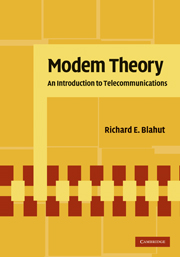Book contents
- Frontmatter
- Contents
- Preface
- Dedication
- 1 Introduction
- 2 Baseband Modulation
- 3 Baseband Demodulation
- 4 Sequences at Baseband
- 5 Passband Modulation
- 6 Passband Demodulation
- 7 Principles of Optimal Demodulation
- 8 Synchronization
- 9 Codes for Digital Modulation
- 10 Codes for Data Transmission
- 11 Performance of Practical Demodulators
- 12 Secure Communications
- Bibliography
- Index
10 - Codes for Data Transmission
Published online by Cambridge University Press: 05 June 2012
- Frontmatter
- Contents
- Preface
- Dedication
- 1 Introduction
- 2 Baseband Modulation
- 3 Baseband Demodulation
- 4 Sequences at Baseband
- 5 Passband Modulation
- 6 Passband Demodulation
- 7 Principles of Optimal Demodulation
- 8 Synchronization
- 9 Codes for Digital Modulation
- 10 Codes for Data Transmission
- 11 Performance of Practical Demodulators
- 12 Secure Communications
- Bibliography
- Index
Summary
The modulator and demodulator make a waveform channel into a discrete communication channel. Because of channel noise, the discrete communication channel is a noisy communication channel; there may be errors or other forms of lost data. A data transmission code is a code that makes a noisy discrete channel into a reliable channel. Despite noise or errors that may exist in the channel output, the output of the decoder for a good data-transmission code is virtually error-free. In this chapter, we shall study some practical codes for data transmission. These codes are designed for noisy channels that have no constraints on the sequence of transmitted symbols. Then a data transmission code can be used to make the noisy unconstrained channel into a reliable channel.
For the kinds of discrete channels formed by the demodulators of Chapter 3, the output is simply a regenerated stream of channel input symbols, some of which may be in error. Such channels are called hard-decision channels. The data transmission code is then called an error-control code or an error-correcting code. More generally, however, the demodulator may be designed to qualify its output in some way. Viewed from modulator input to demodulator output, we may find a channel output that is less specific than a hard-decision channel, perhaps including erasures or other forms of tentative data such as likelihood data on the set of possible output symbols.
- Type
- Chapter
- Information
- Modem TheoryAn Introduction to Telecommunications, pp. 349 - 398Publisher: Cambridge University PressPrint publication year: 2009



